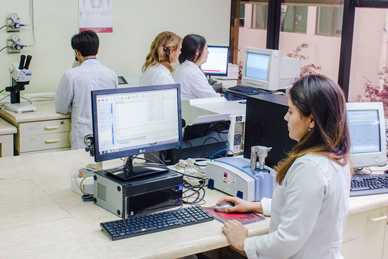Universidad de Santiago was awarded 900 million Chilean pesos in the V version of the Contest Anillos Research Projects in Science and Technology. The contest was announced by the National Commission for Scientific and Technological Research.
Universidad de Santiago was awarded 900 million Chilean pesos for the execution of two projects in the context of the V version of the Contest Anillos Research project in Science and Technology 2014.
Thanks to the Associative Research Program (PIA, in Spanish), 17 projects will be funded nationwide, all of them top-class studies with international scope.
Dr Óscar Bustos Castillo, Vice President of Research, Development and Innovation, said that he was very pleased with the results, adding that “this type of project allows developing cutting-edge research that goes beyond our borders, and this is highly significant to contribute to our university’s internationalization.”
Dr Bustos highlighted that two of the projects that were awarded funding belong to consolidated research groups that, in the short term, could become research centers.
“These study projects will be executed over three years and will allow us to face issues of national interest and global challenges, restating the role we play as a state and public university,” he said.
The projects
One of the projects is led by Dr Maritza Páez and Dr María Victoria Encinas, researchers at the Faculty of Chemistry and Biology, and Dr Jenny Blamey, researcher at Fundación Biociencia, who will address the problems generated by the spontaneous and undesirable damage of materials, known as corrosion or biocorrosion. The name of the study is “Functionalized surfaces: protection against corrosion and biocorrosion.”
They have the goal of replacing the anti corrosion procedures that involve chemical compounds of high toxicity, like chromates, and provide effective and eco-friendly solutions.
Dr Francisco Melo (surface mechanics), Dr José Zagal (electrochemistry) and Dr Manuel Azocar (bioinorganic chemistry) will participate in the project.
Dr Marcela Urzúa (polymers) and Dr Marco Flores (surface physics), both researchers at Universidad de Chile, will take part in the project too, as well as Dr Jenny Blamey and Dr Freddy Boehmwald (microbiology), of Fundación Biociencia, and Dr Mamie Sancy (corrosion-electrochemistry), of the Chilean Air Force.
The second project is led by Dr Raúl Cordero, researcher at the Department of Physics. This is the second time that he leads an Anillo Project (the first time was in 2010). This time, he seeks to better understand the effects of black carbon at the Andean cryosphere.
Black carbon or soot is a pollutant generated by the use of fossil fuels in the cities that is carried by the wind over the Andean snow, changing its reflectivity and its melting speed.
According to Dr Cordero, the study “is mainly focused on measuring the content of black carbon in the snow on the west side of the Andes.” For this purpose, they will conduct campaigns to collect samples and analyze their carbon content across the country, from Putre to the Patagonia.
With this data, “we expect to generate a map that shows the black-carbon content in the Andean cryosphere, highlighting the areas of impact. This information will be useful to evaluate the effect of black carbon on glaciers melting,” the researcher explained.
The project is really important, because the country’s long-term sustainability depends on the availability of water resources coming from the Andean snows. However, just like many cold regions of the planet, the Andean cryosphere has doubled the global warming rate. “Although green-house gas emissions seem to be the main cause of this problem, black carbon may be playing a role too,” he added.
“Universidad de Santiago is a leader in interdisciplinary studies that address different aspects of sustainability, what largely explains the successful results of our applications. This project involves an interdisciplinary team of physicists, chemists, glaciologists and engineers of six renowned Chilean universities. Besides, ten international institutions will collaborate with the project, like the German Aerospace Center (DLR, in German) and the Japan Agency for Marine-Earth Science and Technology (JAMSTEC),” Dr Cordero concluded.
Nationwide results
The other 15 projects that were awarded funds belong to the following universities: five to Universidad Católica de Chile; four to Universidad de Chile; two to Universidad Técnica Federico Santa María and one to Universidad de La Frontera, one to Universidad Adolfo Ibáñez, one to Universidad Andrés Bello and one to Universidad Autónoma de Chile.
Translated by Marcela Contreras



